Despite the massive number of kaiju films released in 1967, most of them aren't particularly memorable. Many were new entrants into the field by studios that had never endeavored to make a giant monster film before. Even Toho's franchise was running out of steam, with the disappointing performance of Son of Godzilla, as well as the flooded market. Godzilla just wasn't as special as he had been. To celebrate the 15th anniversary of the Godzilla franchise in 1968, Toho decided to get the band back together.
And with immaculate timing, my DVD player has decided it no longer likes my copy. Pictures will come later, sadly.
Destroy all Monsters is the last film with the five original artists from Godzilla; Ishiro Honda, Eiji Tsuburaya (although only in an honorary fashion, he was very ill as this time), Tomoyuki Tanaka as producer, Haruo Nakajima in the suit, and Akira Ifukube writing the music. Some call this the end of an era, but to my mind, it's a Hercluean effort before economic and social forces turned the kaiju film into a cheap and poorly thought-out spectacle.
The year is 1999, and as in several previous films, Japan (or, really UNSC) has a space program. They have also managed to confine all the monsters to a location, Monster Land. The space program trope fades a bit after the excitement of the space race cooled off, but the Monster Island idea is one that stuck with the franchise until the end of the Shōwa era. Moonlight SY-3 is a stylish, almost art deco spacecraft, combining attributes of a high-tech jet as well as a rocket.
Ogasawara Island, called Monster Land, is the culmination of several ideas previous films, such as Mothra vs Godzilla and Ebirah, Horror of the Deep. Although the monsters are not under human control, they are at least confined. If Godzilla and the other monsters are still seen as a metaphor for nuclear testing, this may coincide with the rise of nuclear power in Japan, with the Mihama Nuclear Power Plant beginning construction outside Tokyo in February of 1967. On the other hand, this is the ultimate expression of Dr. Serizawa's desire to study the monsters. Now that they are controlled, they can be understood.
The Kilaaks, the alien antagonists, can control the monsters. Japan can never do so, merely containing the monsters, but alien invaders and terrorist corporations such as the Red Bamboo seek to control the giant monsters for their own ends. Ghidorah is, again, the puppet of an alien intelligence just as he was for the Xiliens and the Futurans. They are all female, all Japanese-looking (despite the more international bent of the film) but this is a disguise. They really look like slugs, and are made of 'living metal.' It turns out that they can control humans just as easily as they can monsters. This creates a paranoia in the film similar to the 1956 film Invasion of the Body Snatchers. Anyone could be a Kilaak agent (until they discover the transmitters which allow the Kilaaks to control humans and monsters).
Strangely, Mothra has shed her unique status as protector of Infant Island, and has been confined in the same way that the other monsters have. Also gone from this film are her twins, the Shobijin, Mothra's interface with humanity. She's just another destructive monster. She's also back in larval form. It's possible (pardon me while I fan-theory) that this is the other larva that hatched in Godzilla vs Mothra and didn't become the Mothra we saw in Ebirah, Horror of the Deep, which I assume is the peacemaker from Ghidorah, the Three-Headed Monster.
The film is very much a retread of the tropes and ideas from Ghidorah. Alien invaders, all the monsters ultimately ganging up against Ghidorah, Godzilla pulling a turn from implacable enemy to unstoppable hero. But where Ghidorah has three monsters attacking the three-headed monster, some seven attack him here. More spectacular, sure, but not as challenging a fight. But more than any previous film, Destroy All Monsters takes a look at the international problem of monsters. Rodan attacks Moscow. Gorasaursus, unseen since King Kong Escapes stands in for Baragon, who was on loan to Tsubaraya's Ultraman. Which is why it is misidentified, as well as shows some rather unlikely tunneling abilities. We are told that Mothra attacks Beijing, and that Manda attacks London, but we don't see these. We do see Godzilla show up in New York harbor and blast the United Nations building with his radioactive breath. 1998 Godzilla is not the first time the big guy took a bite out of the Big Apple.
In the middle of the film (XXX minutes), we have a beautiful miniature of 1999 Tokyo. Small card move along her streets, an elevated train trundles along tracks. The set is large and took a lot of attention to detail. Ironic, really that the construction boom made Tokyo so much more impressive thirty years later. The destruction of Tokyo by Godzilla, Rodan, Manda, and Mothra is beautiful in its mayhem.
For the first time since Godzilla Raids Again, the camera pans over the charred and ruined city. This was one of the most effective shots of the original Godzilla film, and it's a reminder that these films aren't completely fun and games. But it's brief, and the devastation isn't as total as it was in 1954.
Part of the bigger budget for this film shows in the miniatures. The military vehicles are a bit more fanciful, including tanks with missiles on their turrets and strange-looking radar antennae. It's as ineffective as the military always is, but it's a pleasure to see some fantasy deigns come from Tsubaraya's studio. There is also the implication, and a prescient one, that the tanks are drones.
The last battle happens, again like Ghidorah, in front of Mount Fuji, where the Kilaak base is. This is our only glimpse of Baragon in the fight, mostly through a thicket. We get a better shot of him in the farewell section, however.
But you have to wonder what the Kilaaks were thinking when they deployed Ghidorah. Godzilla, Rodan, and Mothra got rid of him last time, now Gorosaurus, Anguirus, Manda, Baragon, Varan and Kumonga (I'm not counting Minilla as a threat) are added to the team. It makes for a more impressive fight, but the outcome is pretty inevitable. Godzilla and Anguirus do most of the heavy lifting (the footage of Ghidorah flying with Anguirus firmly attached to one of its necks will be repeated a few times in later films) in the fight.
Once the fight is over, the Kilaaks deploy their Fire Dragon, a flying saucer burning with energy. Even though Godzilla puts an enormous foot through the Kilaak base, the Fire Dragon keeps coming. Ghidorah's inert body falls into the earth, similar to the way Frankenstein and Baragon ended. Only with more explosions, but it's up to the humans to solve the last problem. Which they do with Moonlight SY-3. This represents a major shift in attitude from Toho's previous films. Honda, who experienced WWII, had never allowed the military solution to be anything but show before this. And, although the conclusion is rooted in science fiction, Moonlight SY-3 fires missiles, causing the saucer to go down. The humans have taken the lead, controlling the monsters, no longer the ir helpless victims.
Destroy All Monsters was intended as a finale to the series, the end of monster films. However, it was so successful (admittedly selling only a hundred thousand tickets more than Son of Godzilla), but in a period of sharply declining attendance, this was seen as a major coup. And so the series continued, albeit with declining budgets.
Next up, Boy Scouts in trouble, and loaded with stock footage.
The personal blog of John Goodrich, including, but not limited to kaiju film and comics involving swamp creatures.
Thursday, December 26, 2013
WHAM! POW! BASH! DESTROY ALL MONSTERS
Thursday, December 19, 2013
Space Monster Wangmagwi the Easily Pronouncable
It turns out that Korea didn't produce one native kaiju film in 1967, they produced two. Ujugoe-in Wangmagwi is an unreleased monster film made entirely in Korea, and released a few months before Yonggary. Unlike Yonggary, Wangmagwi was an entirely Korean production. It was believed lost until a copy was discovered in the last decade. It is still undergoing restoration.
Which means I can't watch it. There are a few descriptions of it, and a couple of pictures, but opinions differ. The most complete description of the creature comes from Koreanfilm.com, which makes it sound both different from the usual run of monster films, while retaining many familiar tropes.
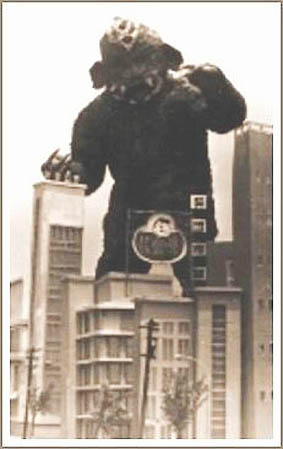
Aliens invade and create the giant monster Wangmagwi, which tromps through downtown Seoul. Ahn Hee, who is due to marry an air force pilot that day (shades of Yonggary) stays in town to wait for him, and it picked up by the monster (very King Kong and carried about. After Seoul is levelled, the monster moves to the countryside, where it can finally be confronted by the military. One very different piece introduced by the film, very different from other monster films, is a himeless boy nicknamed Squirrel. Cornered, Squirrel leaps onto Wangmagwi, climbs into his ear, and attacks the creautre with a knife. What effect this has on the monster, I don't know.
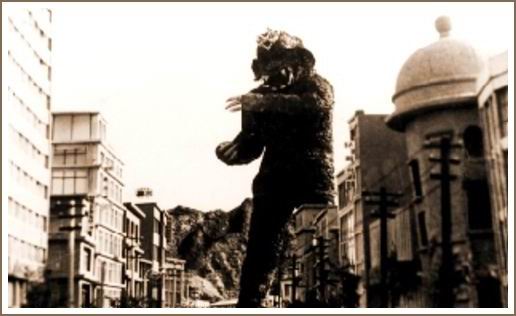
It also seems that Wangmagwi ow some design inspiration to Creature from the Black Lagoon. It's scaly, and spends a lot of time hauling a woman around.
Beyond that, I can only hope that the film gets restored and is released on DVD. I know that I'm not alone in this.
Your Boxing Day present, will be 1968's classic Destroy All Monsters. And that's going to be a load of fun.
Which means I can't watch it. There are a few descriptions of it, and a couple of pictures, but opinions differ. The most complete description of the creature comes from Koreanfilm.com, which makes it sound both different from the usual run of monster films, while retaining many familiar tropes.

Aliens invade and create the giant monster Wangmagwi, which tromps through downtown Seoul. Ahn Hee, who is due to marry an air force pilot that day (shades of Yonggary) stays in town to wait for him, and it picked up by the monster (very King Kong and carried about. After Seoul is levelled, the monster moves to the countryside, where it can finally be confronted by the military. One very different piece introduced by the film, very different from other monster films, is a himeless boy nicknamed Squirrel. Cornered, Squirrel leaps onto Wangmagwi, climbs into his ear, and attacks the creautre with a knife. What effect this has on the monster, I don't know.

It also seems that Wangmagwi ow some design inspiration to Creature from the Black Lagoon. It's scaly, and spends a lot of time hauling a woman around.
Beyond that, I can only hope that the film gets restored and is released on DVD. I know that I'm not alone in this.
Your Boxing Day present, will be 1968's classic Destroy All Monsters. And that's going to be a load of fun.
Thursday, December 12, 2013
It (Mostly) Came From Korea: Yonggary
What amazes me so much about Yonggary (1967) is how startlingly it resembles other films released in the same year. Yonggary is a South Korean production and used some of the special effects guys from Daiei. As a result, Yonggary looks a bit familiar with his large lower jaw fangs (shades of Gamera, a blowtorch breath weapon (Gamera Again), and a glowing horn (shades of Barugon. The film also has an annoying child as a protagonist.
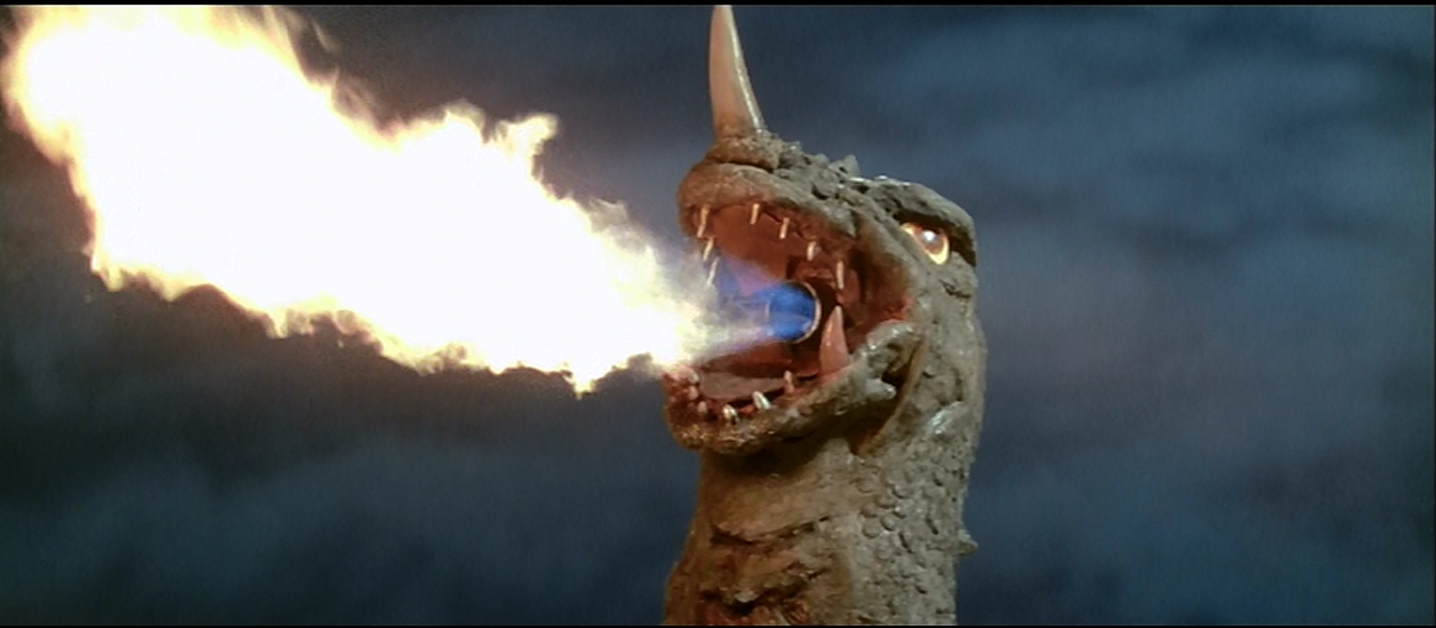
But early on, the film feels a lot like Giant Space Monster Guilala or Invasion of Astro-Monster, because South Korea has a manned space program. This is, oddly, a deal breaker for some reviewers, who consider it ridiculous. But a film-maker from a country that had no space program in the 60's really didn't have much choice. Either they could make everyone involved in the program American or Russian, but where were they going to find that many American or Russian actors, and why would they all be speaking Korean or Japanese? But beyond that, kaiju films are a mix of science fiction and fantasy, and why shouldn't a country which is proud of its achievements, dream that one day they will also reach for the stars?
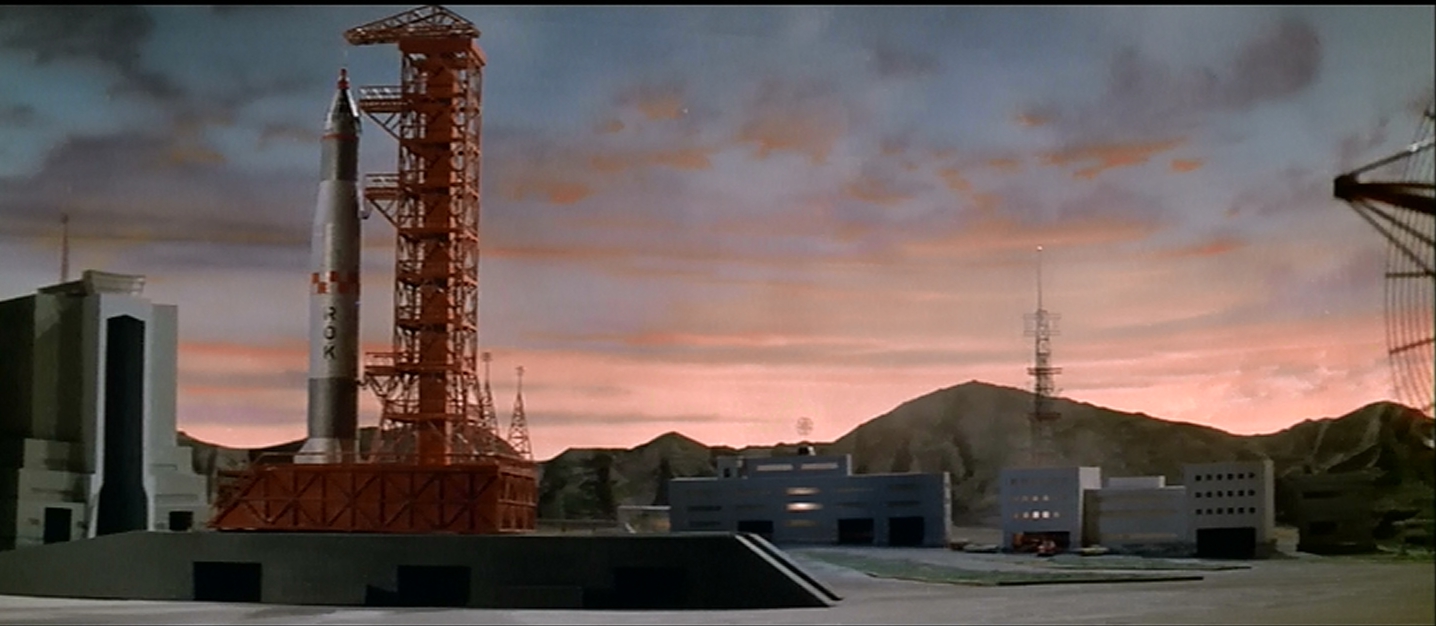
Unfortunately, the Korean cut of this film has been lost. All that I can access is the AIP dub of the film. And I feel that dubs tend to water down the acting abilities of the cast, making them less sympathetic.
Early in the film, we discover that Icho is a protagonist. He's a precocious kid, who has developed an ithcing ray that he inflicts on a pair of newlyweds. Ho ho, what a great character! We'll be seeing a lot of him.
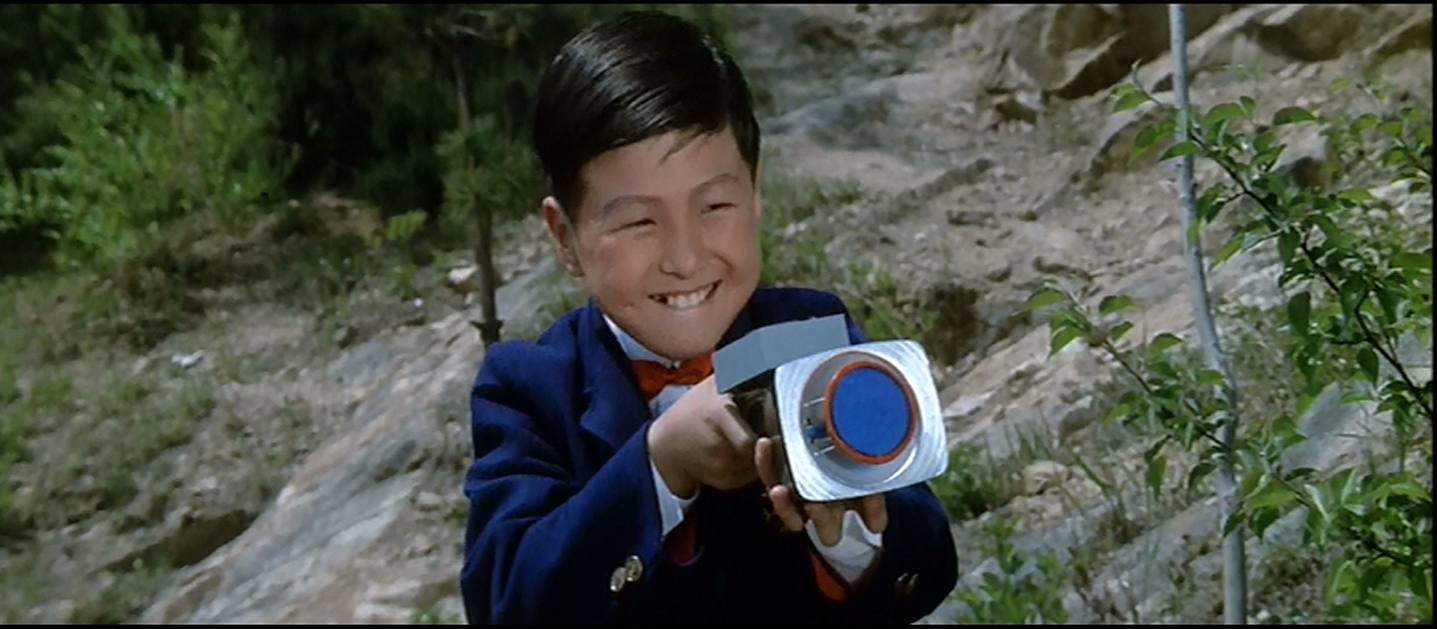
Yonggary is only sort of a nuclear monster. A nuclear detonation goes off... somewhere, and then an earthquake burrows its way to Seoul. Like many later films, Yonggary seems to be more about the threat of nuclear war than a protest of nuclear testing as was the original Godzilla. Which is certainly explicable; Korea was much more affected by the Cold War than by nuclear testing. It is notable, however, that the gigantic monster comes from far away and travels to Korea for no known reason. If Godzilla had a tenuous claim to being a symbol of American military might, Yonggary could also be read that way. But we never know whose nuclear weapon is dropped, and this is after China's initial nuclear tests, so this could be a projection of Korea's fears of Chinese nuclear aggression.
Yonggary itself first shows after twenty-six minutes, so we haven't been waiting around for long. Our first gimpse is his back, which bears a stubby triple fun pattern, likely borrowed from Godzilla. Overall, the suit is pretty good. The reticulated front pattern is a particularly nice touch. Unfortunately, and I don't know if this is a fault of the AIP translation or not, Yonggary has the same cry. Every time. It's a good cry, metallic and menacing, but it's the same damn one every time it opens its mouth. Further, they do not match the motions of Yonggary's mouth. The cry is drawn-out, but the mouth is always going, which makes Yonggary look like he's chewing gum.
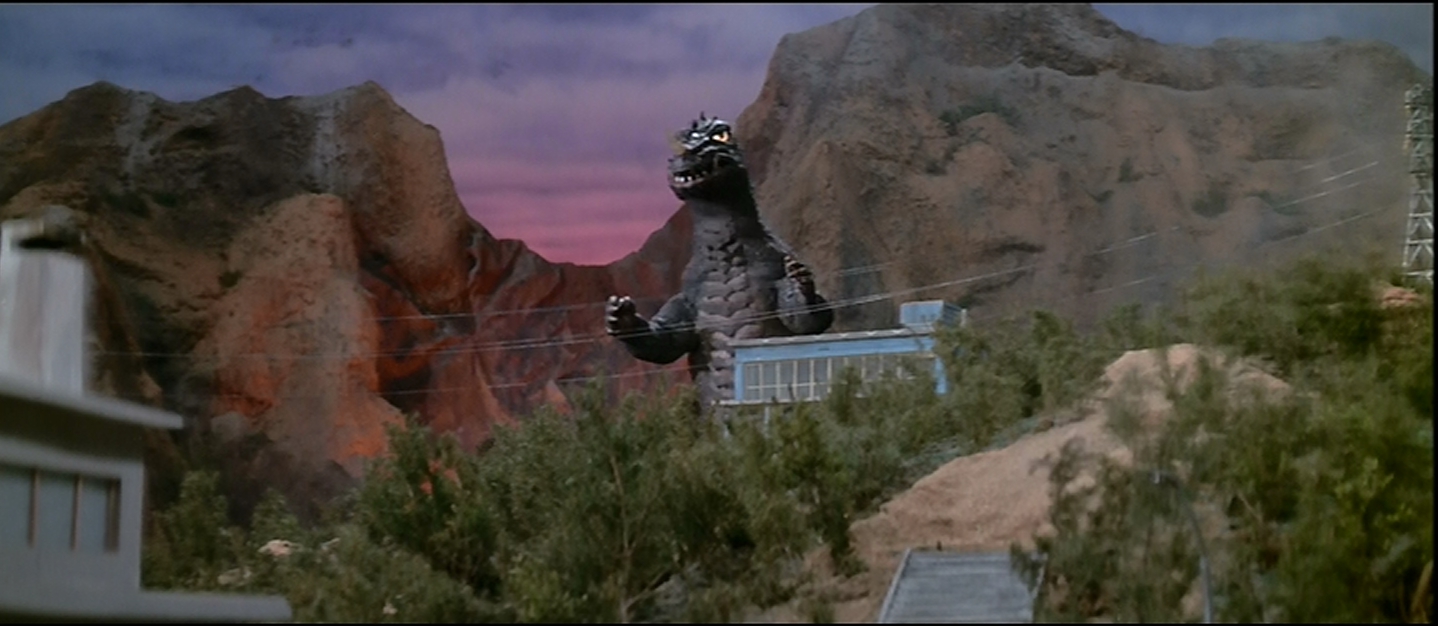
There are several common sequences in the film, panicked people running to escape the monster, the preacher glad that the end of days is finally here (a nice reference to Gorgo), the greedy businessmen feasting with nihilistic abandon, the kids dancing their cares away, the initial efforts of the military, the symbolic melting of the first tank.
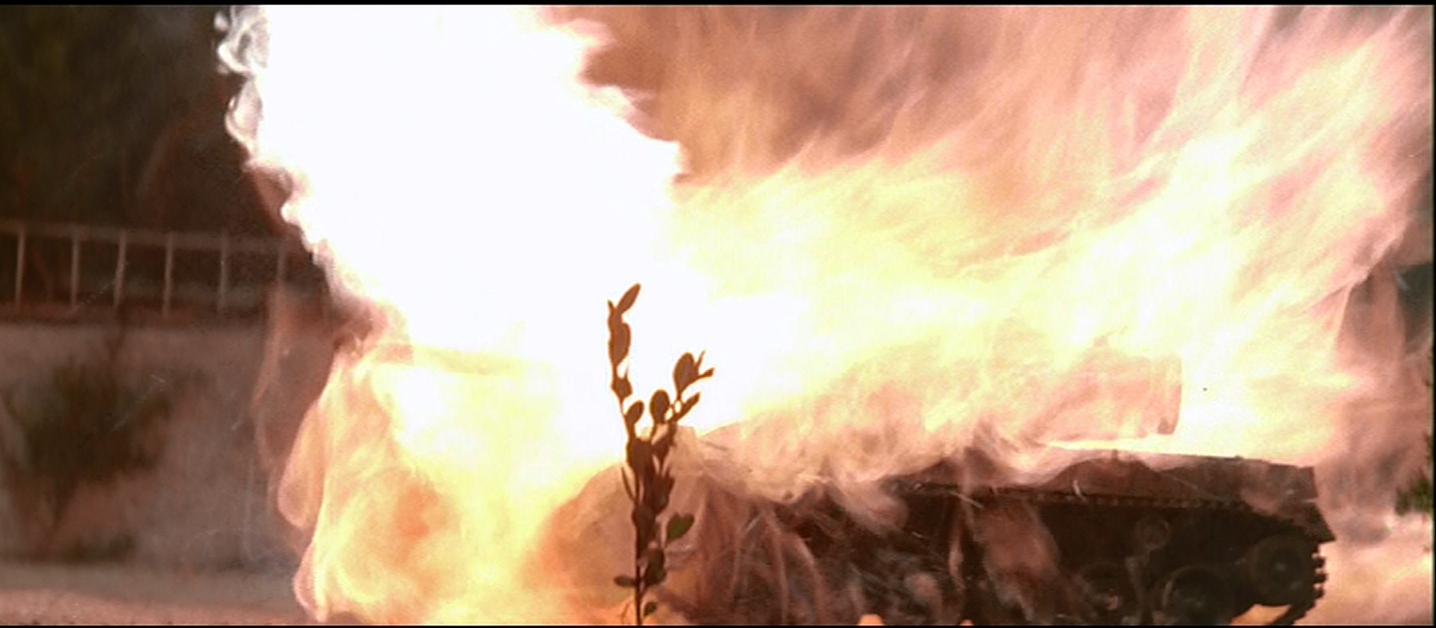
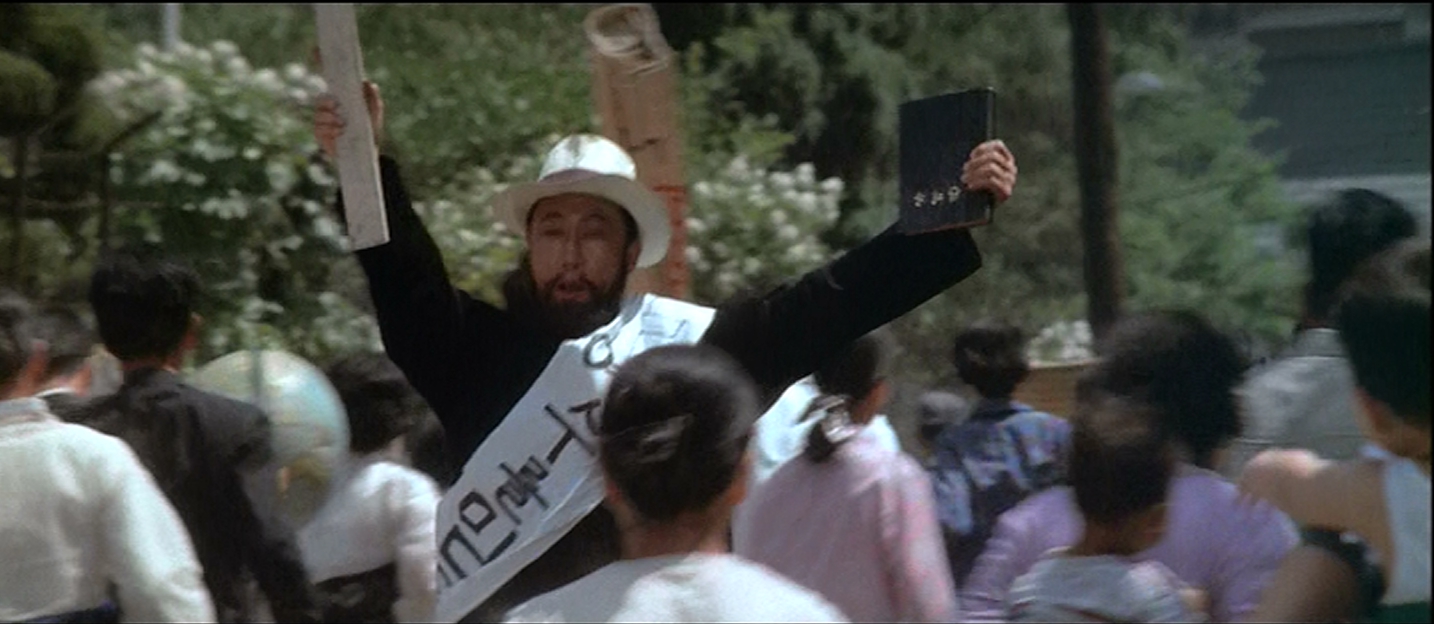
The rampage is witnessed by the adult protagonist (Ilo) and the kid (Icho), and Icho finds a novel way to experience the monster close at hand, by climbing down a manhole. Yonggary steps directly on the manhole, which gives a moment of tension, despite my dislike of the Icho character. It's a clever way to get Icho very close to Yonggary.
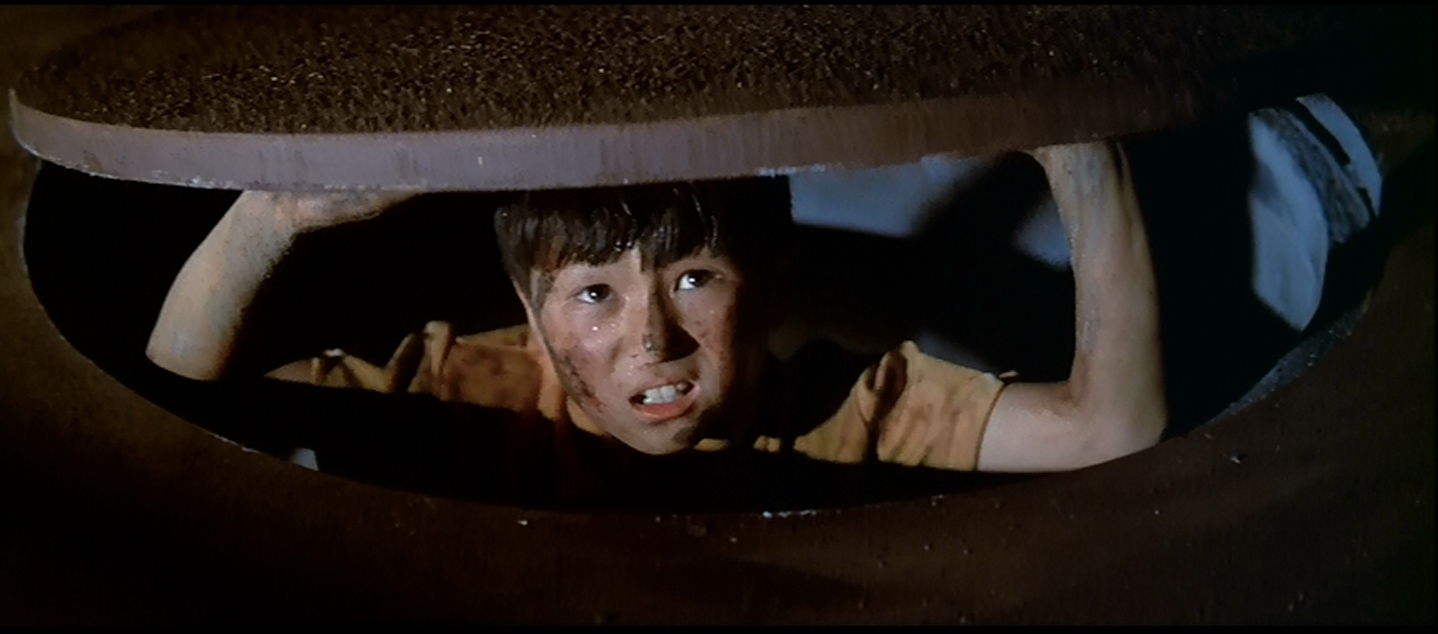
Yongarry can be distracted by helicopters that fly slowly, and so it is lead out of Seoul into a refinery where, in another tribute to Gamera, he sucks down a storage tank of oil. But when he destroys a container full of ammonia, he begins to itch at himself, providing Icho with the clue he needs to eventually destroy the monster. The Korean military then uses some experimental missiles on Yonggary, which of course doesn't work. But first, there's a strange interlude in which beach music plays and Yonggary dances. It's a really weird bit, possibly to give the monster more sympathy, because nothing makes the heart sing like a kid and giant monster dancing together.
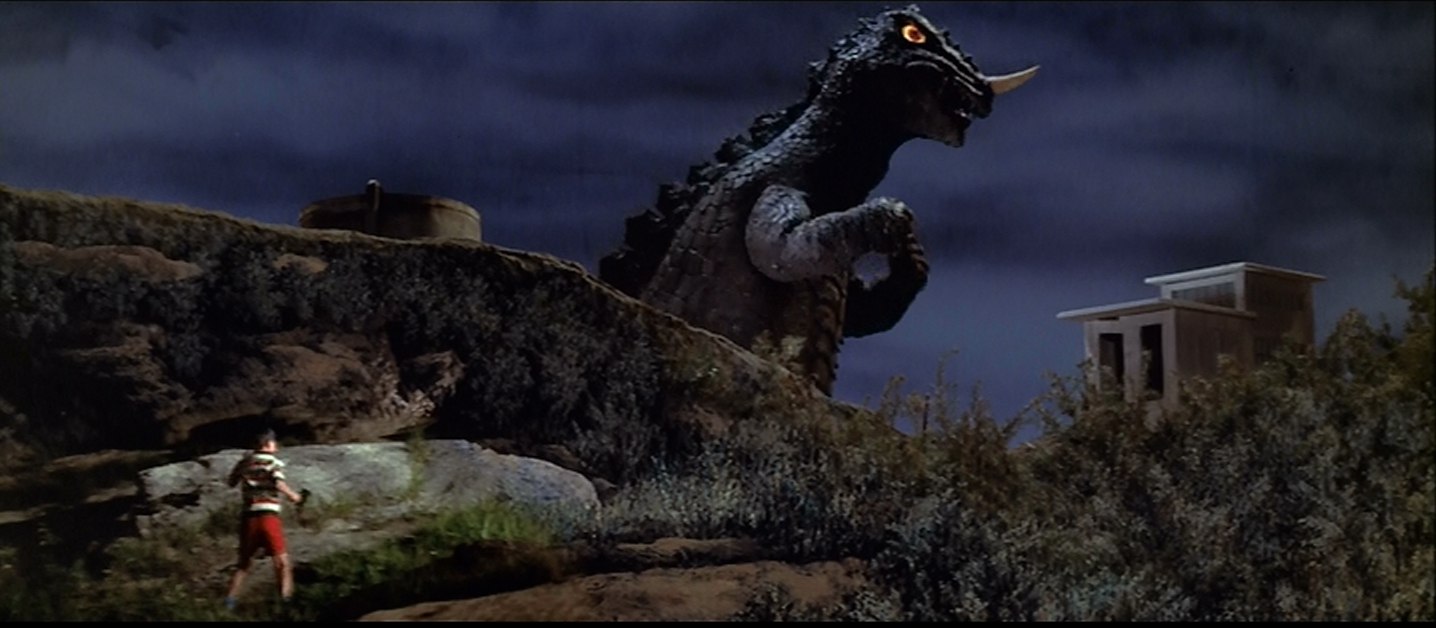
After which he really nails his debt to Gamera by using his nose horn beam to slice a jeep in half. Exactly the same trick (with the same problem--again, you can see the supporting wheel in the sliced-open Jeep) way that Gyaos did.
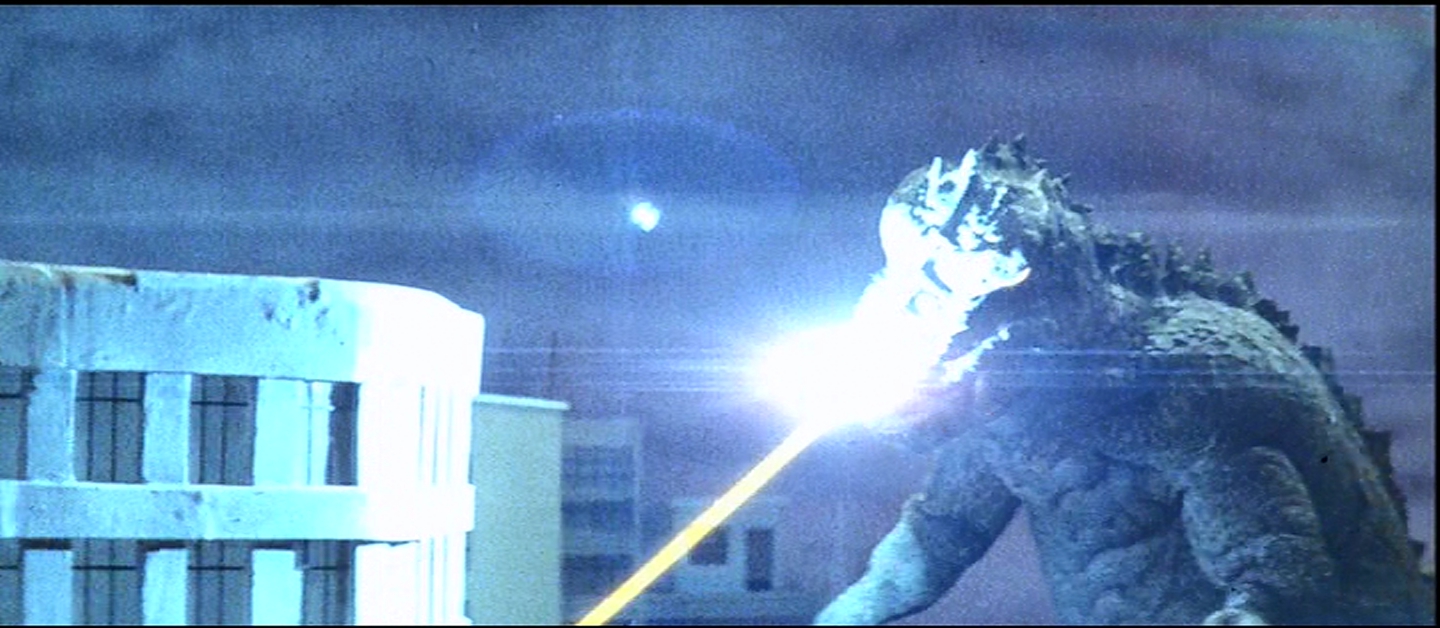
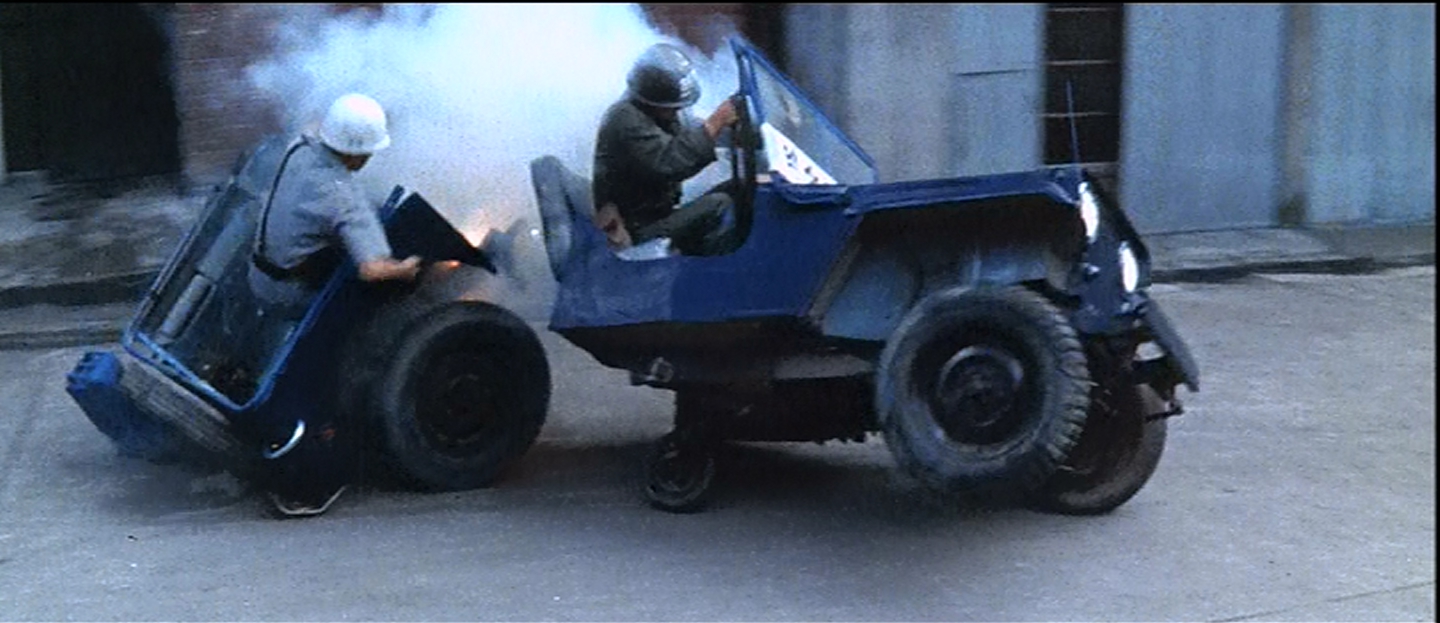
There's a moment, as planes attack, that the Yonggary suit catches fire, just below the left eye. This leaves a notable chunk of the rubber skin flapping around for the rest of the sequence. Probably a good thing they film the scenes with explosions last.
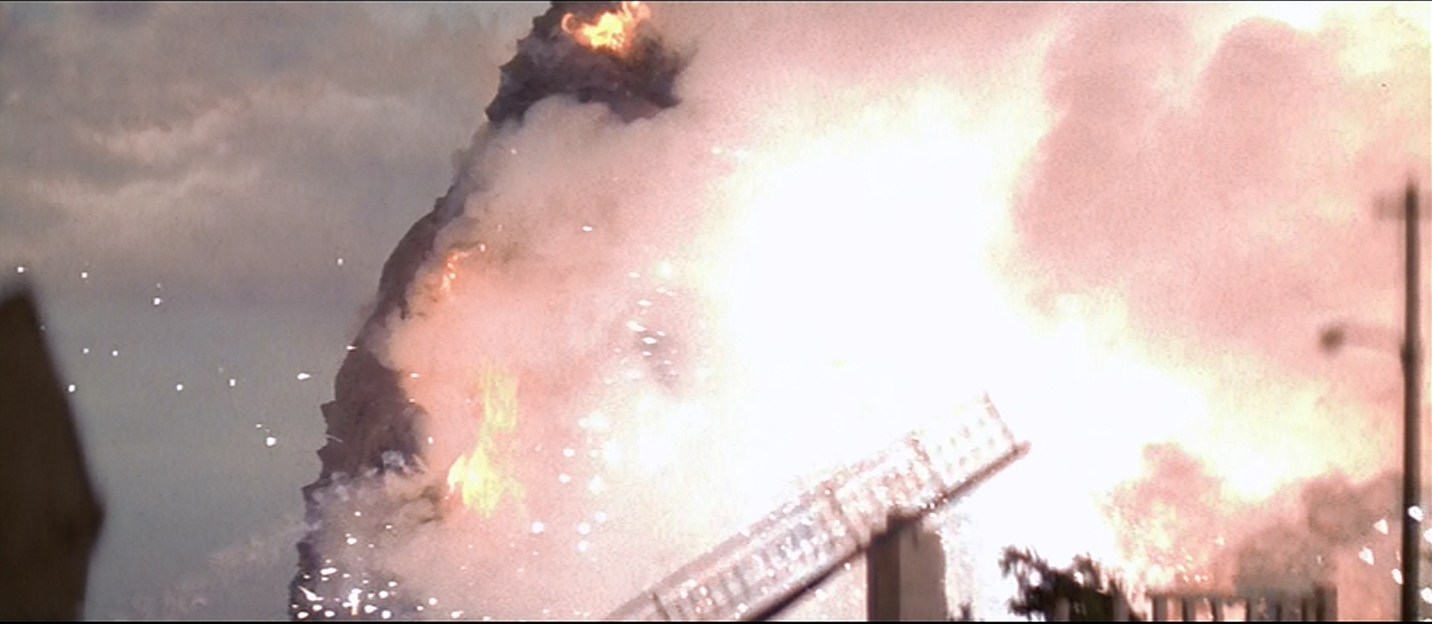
Further, as the polits retreat, Yonggary uses his nose horn to slice one of the Lockheed F-104 Starfighters in half. This might even be the same model that we saw Gyaos slice through.
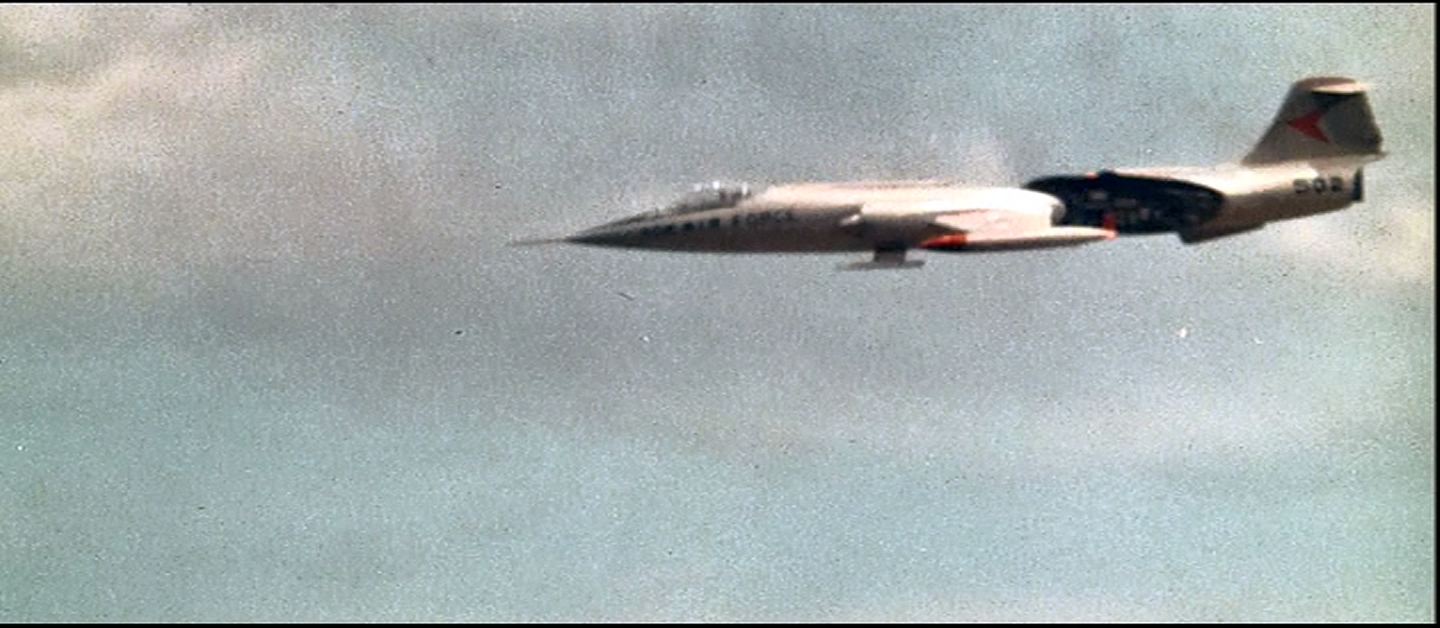
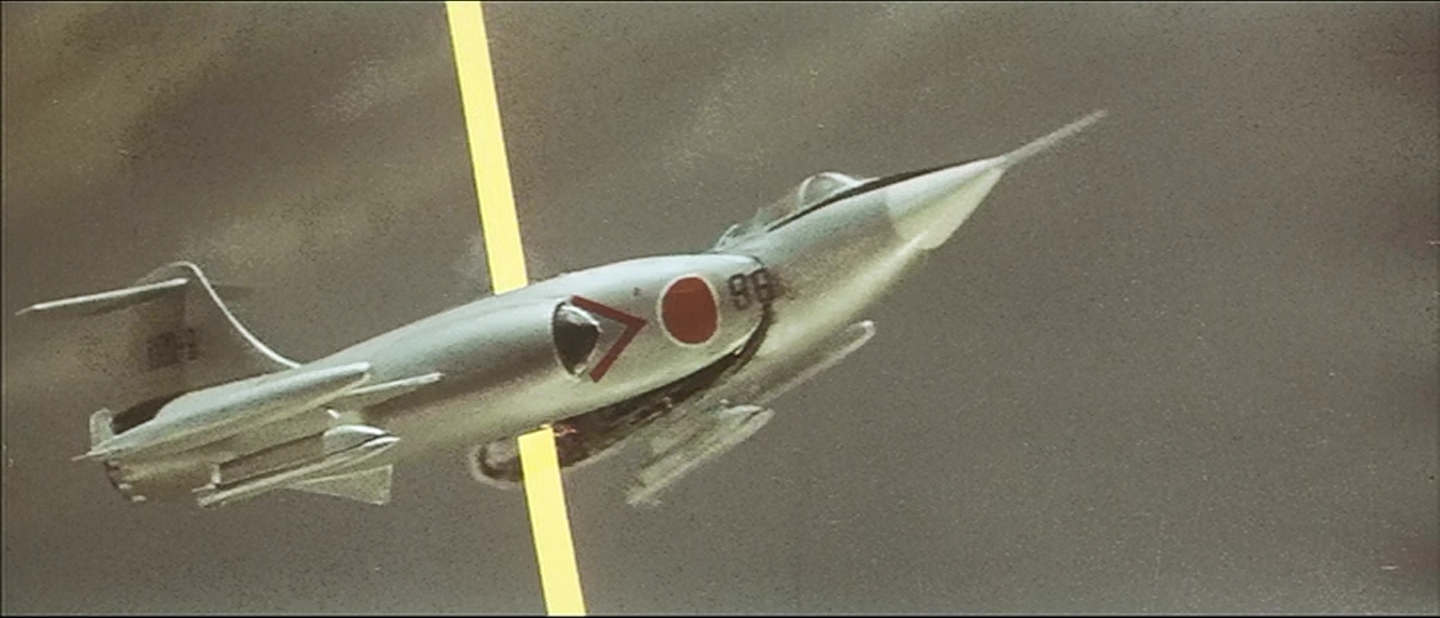
But the monster cannot be allowed to live. Ilo and Icho, in a helicopter, drop loads of ammonia on Yonggary, who collapses, twitches, and bleeds out in one of the more disturbing monster deaths. Of course, Ilo has his fiance up in the helicopter, and she's laughing about it. The film is surprisingly tone-deaf about its emotional tenor.
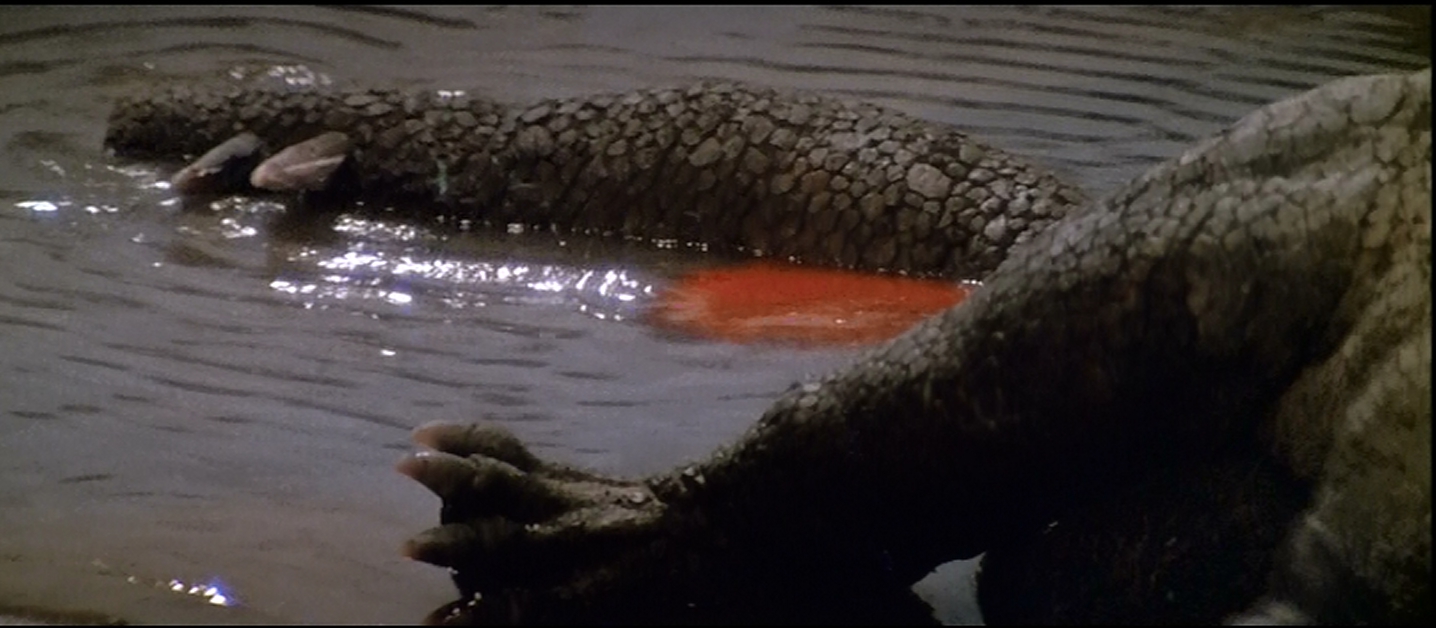
Despite my complaints, I do enjoy Yonggary. The monster effects are decent, and it's got a couple fresh ideas. The child is pretty annoying, but the long monster effects sequences make this easier to bear. As far as transfer goes, the MGM Mignight Movie version, a double sided disk with Konga, is definitely the best. Presented in widescreen, it's also notable less muddy than other versions I have owned.

Yonggary was reimagined around the same time, and in the same spirit of Godzilla 1998. Which is to say it has almost nothing to do with the original film. A second edit was made for release to Western audiences, and the original Korean version is unavailable. We'l get to it in due time.
Next week, a monster whose name I can't pronounce, once again from a movie I haven't seen.

But early on, the film feels a lot like Giant Space Monster Guilala or Invasion of Astro-Monster, because South Korea has a manned space program. This is, oddly, a deal breaker for some reviewers, who consider it ridiculous. But a film-maker from a country that had no space program in the 60's really didn't have much choice. Either they could make everyone involved in the program American or Russian, but where were they going to find that many American or Russian actors, and why would they all be speaking Korean or Japanese? But beyond that, kaiju films are a mix of science fiction and fantasy, and why shouldn't a country which is proud of its achievements, dream that one day they will also reach for the stars?

Unfortunately, the Korean cut of this film has been lost. All that I can access is the AIP dub of the film. And I feel that dubs tend to water down the acting abilities of the cast, making them less sympathetic.
Early in the film, we discover that Icho is a protagonist. He's a precocious kid, who has developed an ithcing ray that he inflicts on a pair of newlyweds. Ho ho, what a great character! We'll be seeing a lot of him.

Yonggary is only sort of a nuclear monster. A nuclear detonation goes off... somewhere, and then an earthquake burrows its way to Seoul. Like many later films, Yonggary seems to be more about the threat of nuclear war than a protest of nuclear testing as was the original Godzilla. Which is certainly explicable; Korea was much more affected by the Cold War than by nuclear testing. It is notable, however, that the gigantic monster comes from far away and travels to Korea for no known reason. If Godzilla had a tenuous claim to being a symbol of American military might, Yonggary could also be read that way. But we never know whose nuclear weapon is dropped, and this is after China's initial nuclear tests, so this could be a projection of Korea's fears of Chinese nuclear aggression.
Yonggary itself first shows after twenty-six minutes, so we haven't been waiting around for long. Our first gimpse is his back, which bears a stubby triple fun pattern, likely borrowed from Godzilla. Overall, the suit is pretty good. The reticulated front pattern is a particularly nice touch. Unfortunately, and I don't know if this is a fault of the AIP translation or not, Yonggary has the same cry. Every time. It's a good cry, metallic and menacing, but it's the same damn one every time it opens its mouth. Further, they do not match the motions of Yonggary's mouth. The cry is drawn-out, but the mouth is always going, which makes Yonggary look like he's chewing gum.

There are several common sequences in the film, panicked people running to escape the monster, the preacher glad that the end of days is finally here (a nice reference to Gorgo), the greedy businessmen feasting with nihilistic abandon, the kids dancing their cares away, the initial efforts of the military, the symbolic melting of the first tank.


The rampage is witnessed by the adult protagonist (Ilo) and the kid (Icho), and Icho finds a novel way to experience the monster close at hand, by climbing down a manhole. Yonggary steps directly on the manhole, which gives a moment of tension, despite my dislike of the Icho character. It's a clever way to get Icho very close to Yonggary.

Yongarry can be distracted by helicopters that fly slowly, and so it is lead out of Seoul into a refinery where, in another tribute to Gamera, he sucks down a storage tank of oil. But when he destroys a container full of ammonia, he begins to itch at himself, providing Icho with the clue he needs to eventually destroy the monster. The Korean military then uses some experimental missiles on Yonggary, which of course doesn't work. But first, there's a strange interlude in which beach music plays and Yonggary dances. It's a really weird bit, possibly to give the monster more sympathy, because nothing makes the heart sing like a kid and giant monster dancing together.

After which he really nails his debt to Gamera by using his nose horn beam to slice a jeep in half. Exactly the same trick (with the same problem--again, you can see the supporting wheel in the sliced-open Jeep) way that Gyaos did.


There's a moment, as planes attack, that the Yonggary suit catches fire, just below the left eye. This leaves a notable chunk of the rubber skin flapping around for the rest of the sequence. Probably a good thing they film the scenes with explosions last.

Further, as the polits retreat, Yonggary uses his nose horn to slice one of the Lockheed F-104 Starfighters in half. This might even be the same model that we saw Gyaos slice through.


But the monster cannot be allowed to live. Ilo and Icho, in a helicopter, drop loads of ammonia on Yonggary, who collapses, twitches, and bleeds out in one of the more disturbing monster deaths. Of course, Ilo has his fiance up in the helicopter, and she's laughing about it. The film is surprisingly tone-deaf about its emotional tenor.

Despite my complaints, I do enjoy Yonggary. The monster effects are decent, and it's got a couple fresh ideas. The child is pretty annoying, but the long monster effects sequences make this easier to bear. As far as transfer goes, the MGM Mignight Movie version, a double sided disk with Konga, is definitely the best. Presented in widescreen, it's also notable less muddy than other versions I have owned.

Yonggary was reimagined around the same time, and in the same spirit of Godzilla 1998. Which is to say it has almost nothing to do with the original film. A second edit was made for release to Western audiences, and the original Korean version is unavailable. We'l get to it in due time.
Next week, a monster whose name I can't pronounce, once again from a movie I haven't seen.
Thursday, December 5, 2013
Because Kaiju Have Feelings, Too: Gappa the Triphidian Monsters
Nikkatsu is the final Japanese studio to participate in the Giant Monster Explosion of 1967. Their offering, Daikyojû Gappa was a staple of afternoon monster fests in the seventies and eighties. Gappa is, like most first studio offerings, a mishmash of ideas from previous films.
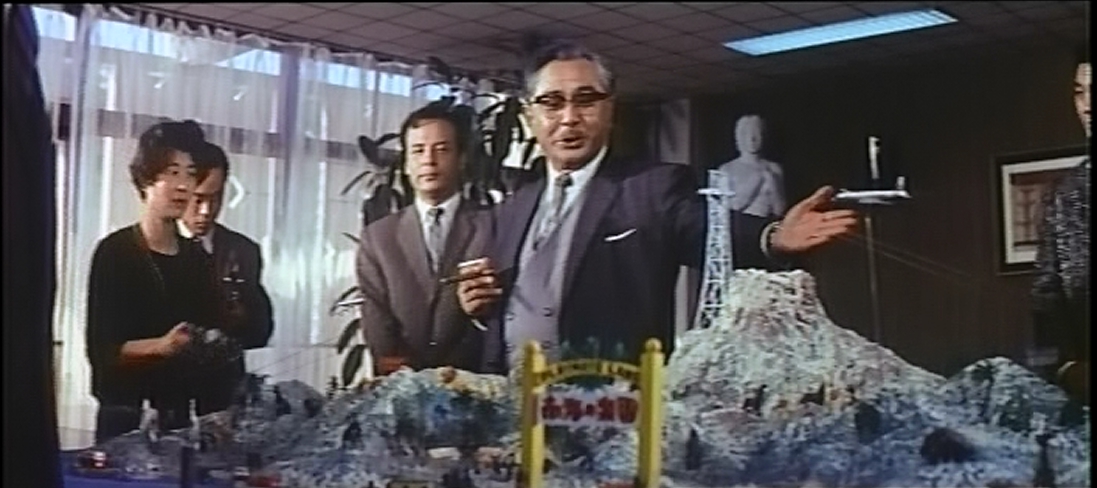
As with Godzilla vs Mothra, the motivator for the plot of the greedy industrialist, in this case the publisher of Playmate magazine. He's bought the island outright, so the indigenous people are going to have to move. The irony is that Nikkatsu was converting itself to producer of soft-core "pink" films.
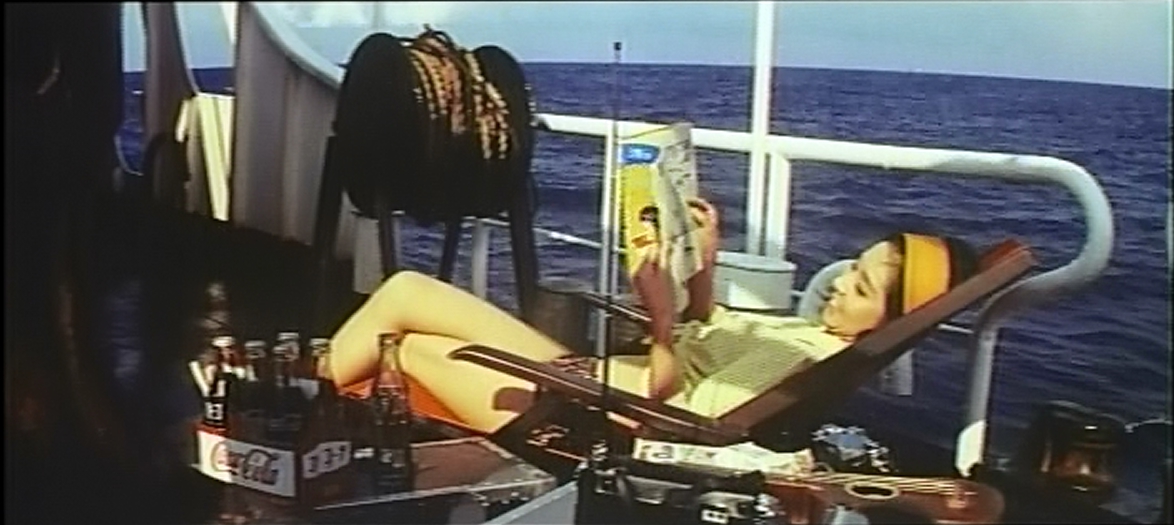
Gappa is the god of Obelisk Island (which joins the archipelago of monster-infested locations such as Odo Island, Infant Island, Devil's Island and Sollgel Island. Nara Island is, of course, in the Atlantic). But the Pacific is large, and jamming one more island in there won't really be noticeable. The natives could have stepped out of either King Kong vs Godzilla or Gamera vs Barugon. The women dance with spears and shields while the men wear breechclots in tartan and other patterns.
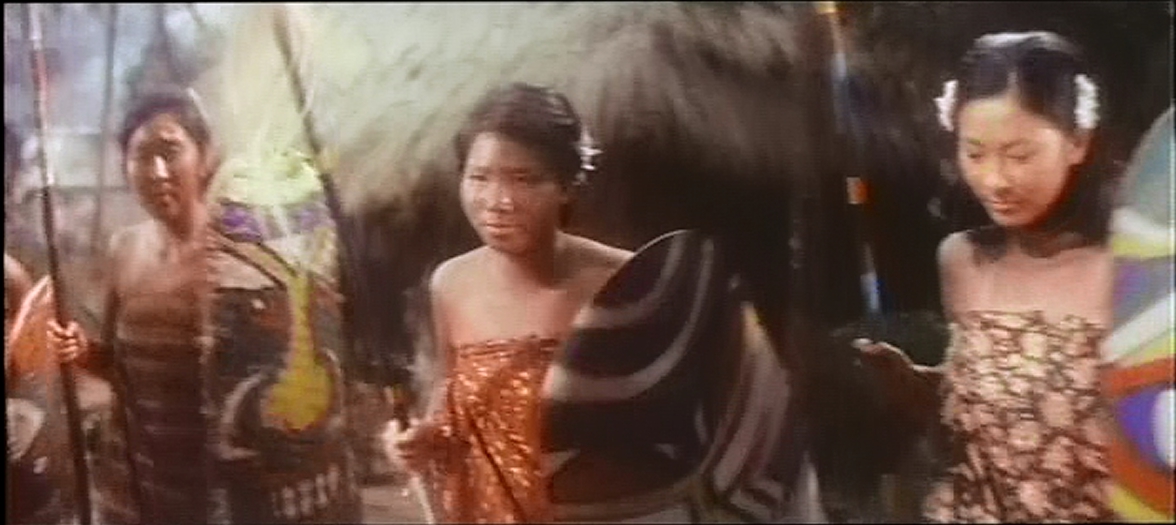
The story itself is well-cribbed from Gorgo. The explorers come to Obelisk Island and capture the immature Gappa. The greedy industrialist intends to put it on display, but this plan is interrupted by the arrival of the parents.
Gappa also includes the era-obligatory child protagonist, Saki here. While not nearly as annoying as many of the Gamera kids, he's in the mould of Sean. He's the connection to the island culture, and the one person, in addition to the only women on the expedition, Itoko, who feels any sympathy for the baby Gappa before its parents begin stomping the city.
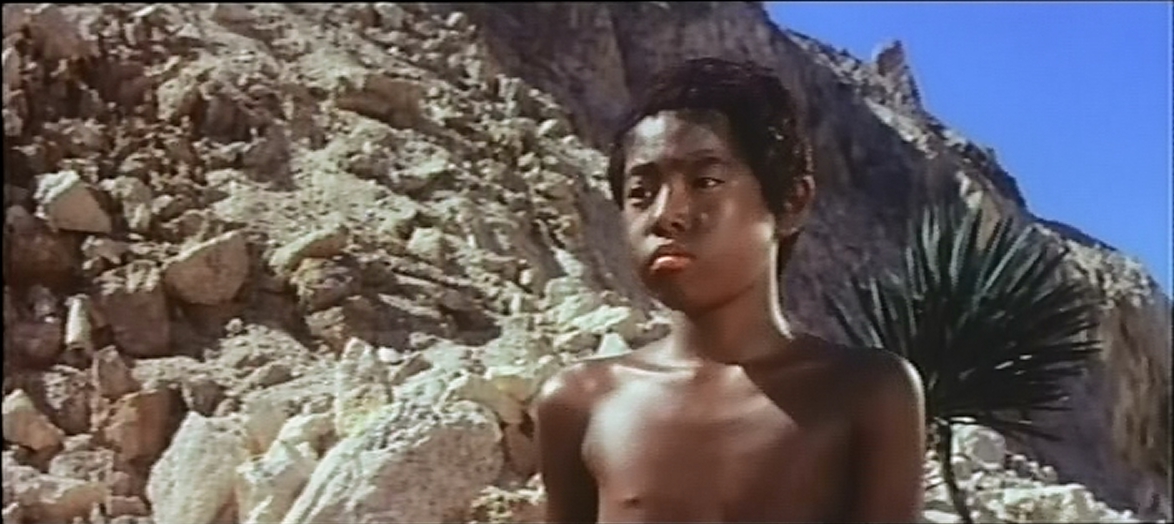
Baby Gappa isn't actually put on display, as it was in Gorgo. Instead, there's some medical experimentation, including making it wear some very strange headgear, to measure the brain waves. This again echoes Gorgo, as well as Minilla, and is a template for the discovery of Godzilla, Jr, from the Heisei series' 1993 Godzilla vs Mechagodzilla.
.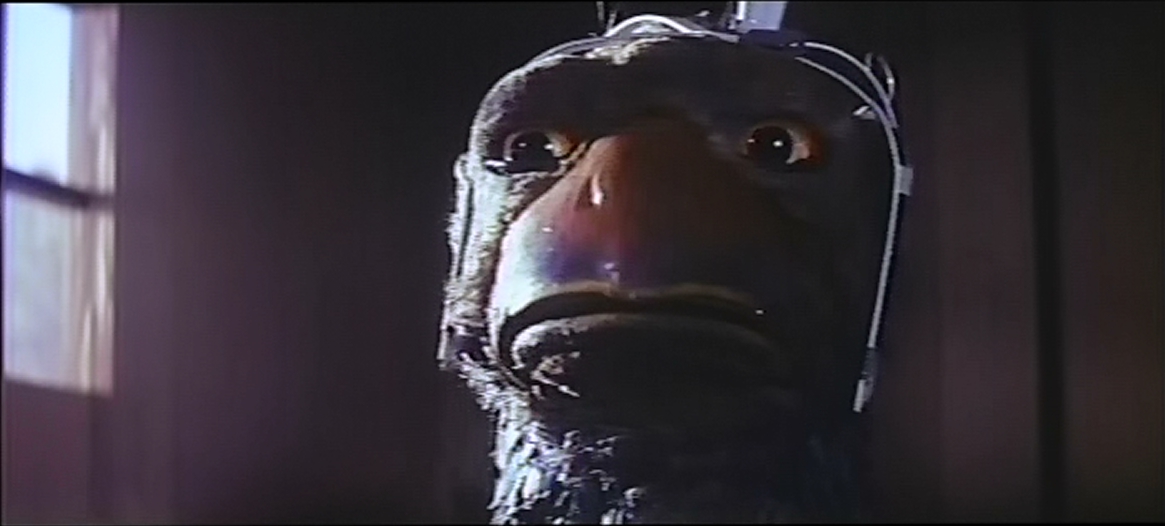
The suits are pretty good. Effects director Akira Watanabe, who worked with Eiji Tsuburaya on Godzilla and and dozen other kaiju films, created the Gappa costumes out of latex, rather than the cloth-based costimes from Daiei. He made some very thoughtful choices. The adult Gappa display sexual dimorphism, the crests on the male and female creatures are different. When the Gappa first appear, one of them is carrying a large octopus in its mouth, which I assume is to feed the baby Gappa. So despite feeling like it was assembled out of ideas from other films, Gappa has a certain amount of originality, and a bit more depth than many films of the period. Which is why I find Gappa, despite the B-plot elements, to be watchable.
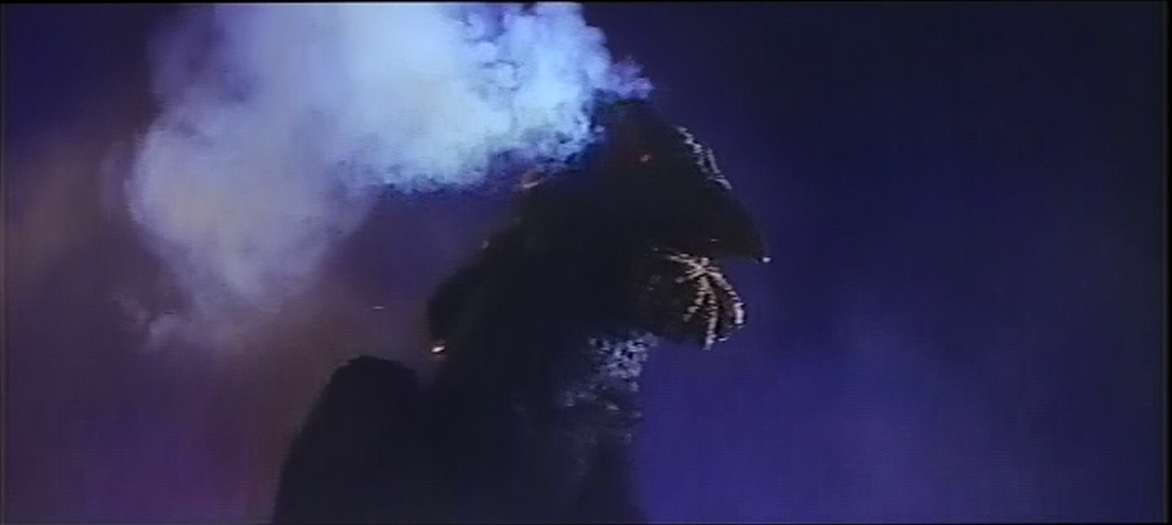
Like Godzilla, the Gappa have some sort of breath weapon, and they uleash it on tanks, first. Like Gorgo, the Gappa are not nuclear mutants. More like Mothra, they are unappeased gods on their own islands. Very little is explained in the film, where they came from, what their breath weapons actually are. But by this time, the monster film audience had likely seen enough monster films thast an explanation was unnecessary. Monsters have some sort of breath weapon.
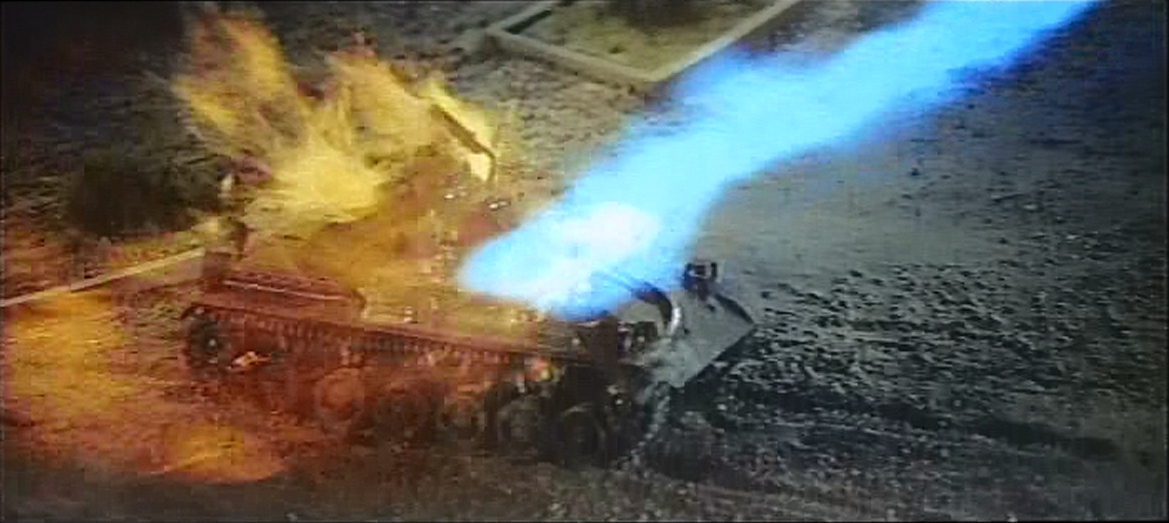
The Gappa combine the size and heat ray of Godzilla with the flight of Rodan, making them very difficult to pin down. They also can breathe underwater, which is what inspired the "triphidian" title from the American DVD release. They hide in a lake while Playmate is selling a crapload of copies, even as the publisher holds the baby Gappa and denies responsibility for the Gappas' rampage. The humans are not sympathetic in this film; the monsters are.
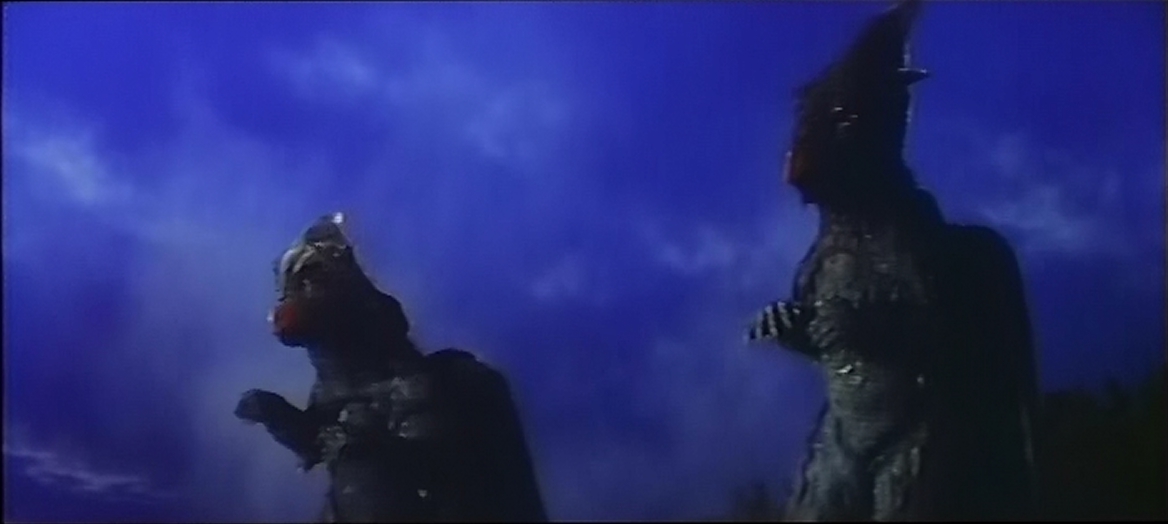
After a bit of stomping the Gappa retire to a lake within sight of Mt. Fuji. The military decide to dislodge the Gappa with high-frequency sound and launch missiles at them when they emerge. While the idea is good, the execution is rather strange. They send boats out into the lake, and then sink them to bring the sound below the surface. I suppose an underwater speaker would have done, but the boats look pretty cool as they sink into the water. It succeeds, and the Gappa come out, ignore the missile surprise waiting for them, and head straight for long-suffering Tokyo.
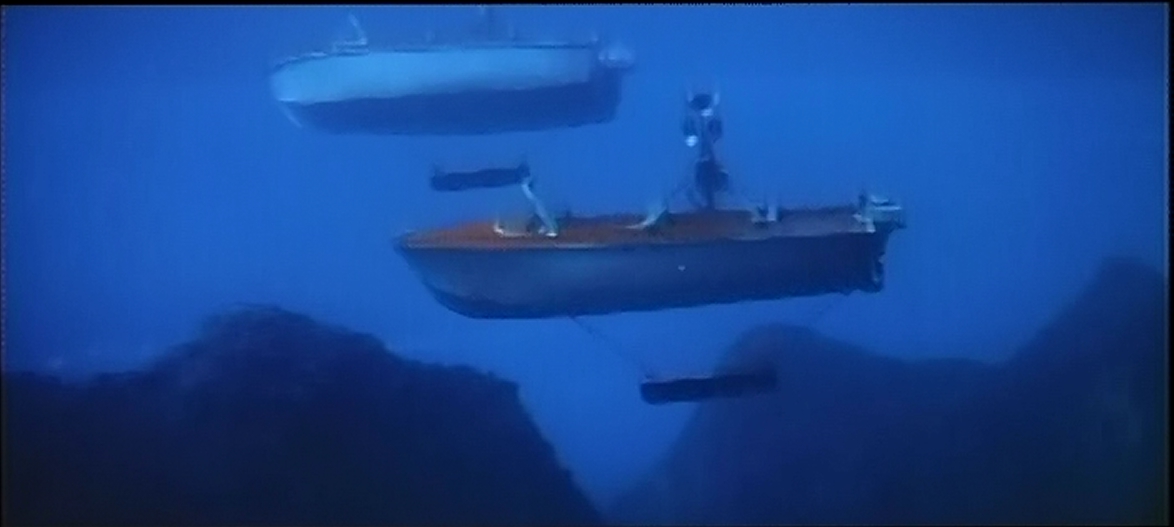
In an attempt to forestall the destruction, baby Gappa is flown to the Tokyo airport in a helicopter and balloon contraption that looks a bit like a modified Kong-moving rig from King Kong vs Godzilla.
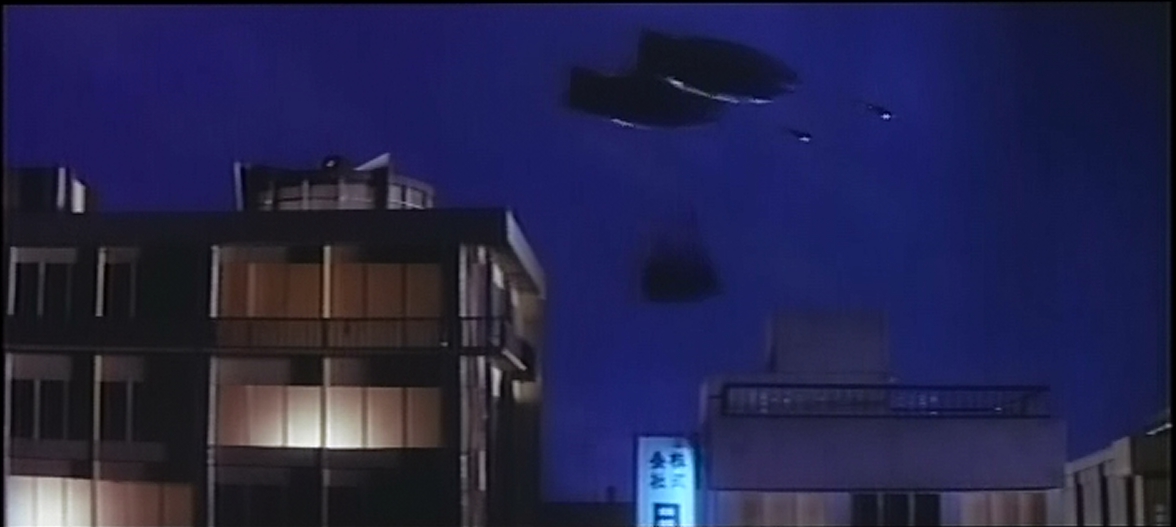
At the airport, the monster family is reunited, and manages to do so in a way that is sweet, without being nauseating. Taking its cute from Gorgo, Gappa aims at children but doesn't pander to them, leaving us with a watchable film that doesn't treat us as if we were intellectually and emotionally stunted. Until the moment that they ruin it by having the token woman decide that she wants to give up her career and have babies. In keeping with the theme of the importance of family, I suppose, but a little hard to take forty-five years later.
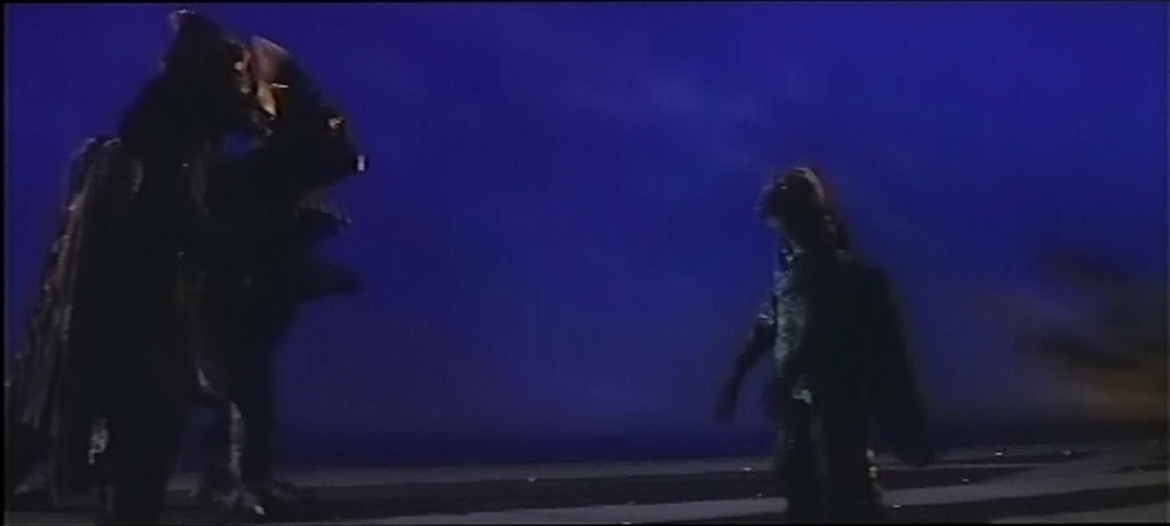
Overall, Gappa is a pretty good giant monster film. It moves along at a decent clip, the kid doesn't get a lot of screen time, and the human subplot is inoffensive (except that last bit). I've watched this more times than any of the Gamera films, and more than several Godzilla films. These pictures were taken from the Tokyo Shock version, which isn't a fantastic transfer, but for the subbed version, this is the only option. The monster sequences are dark, and they have significant more scratching than the non special effects sections. I hope that with the success of Pacific Rim and the anticipated success of Godzilla 2014, we'll be able to get several of the more obscure films onto a good transfer, whether on DVD or Blu-Ray.
Next, we move out of Japan, but not out of Asia. The overly-familiar Yonggary, next week on My Week of Monsters.

As with Godzilla vs Mothra, the motivator for the plot of the greedy industrialist, in this case the publisher of Playmate magazine. He's bought the island outright, so the indigenous people are going to have to move. The irony is that Nikkatsu was converting itself to producer of soft-core "pink" films.

Gappa is the god of Obelisk Island (which joins the archipelago of monster-infested locations such as Odo Island, Infant Island, Devil's Island and Sollgel Island. Nara Island is, of course, in the Atlantic). But the Pacific is large, and jamming one more island in there won't really be noticeable. The natives could have stepped out of either King Kong vs Godzilla or Gamera vs Barugon. The women dance with spears and shields while the men wear breechclots in tartan and other patterns.

The story itself is well-cribbed from Gorgo. The explorers come to Obelisk Island and capture the immature Gappa. The greedy industrialist intends to put it on display, but this plan is interrupted by the arrival of the parents.
Gappa also includes the era-obligatory child protagonist, Saki here. While not nearly as annoying as many of the Gamera kids, he's in the mould of Sean. He's the connection to the island culture, and the one person, in addition to the only women on the expedition, Itoko, who feels any sympathy for the baby Gappa before its parents begin stomping the city.

Baby Gappa isn't actually put on display, as it was in Gorgo. Instead, there's some medical experimentation, including making it wear some very strange headgear, to measure the brain waves. This again echoes Gorgo, as well as Minilla, and is a template for the discovery of Godzilla, Jr, from the Heisei series' 1993 Godzilla vs Mechagodzilla.
.

The suits are pretty good. Effects director Akira Watanabe, who worked with Eiji Tsuburaya on Godzilla and and dozen other kaiju films, created the Gappa costumes out of latex, rather than the cloth-based costimes from Daiei. He made some very thoughtful choices. The adult Gappa display sexual dimorphism, the crests on the male and female creatures are different. When the Gappa first appear, one of them is carrying a large octopus in its mouth, which I assume is to feed the baby Gappa. So despite feeling like it was assembled out of ideas from other films, Gappa has a certain amount of originality, and a bit more depth than many films of the period. Which is why I find Gappa, despite the B-plot elements, to be watchable.

Like Godzilla, the Gappa have some sort of breath weapon, and they uleash it on tanks, first. Like Gorgo, the Gappa are not nuclear mutants. More like Mothra, they are unappeased gods on their own islands. Very little is explained in the film, where they came from, what their breath weapons actually are. But by this time, the monster film audience had likely seen enough monster films thast an explanation was unnecessary. Monsters have some sort of breath weapon.

The Gappa combine the size and heat ray of Godzilla with the flight of Rodan, making them very difficult to pin down. They also can breathe underwater, which is what inspired the "triphidian" title from the American DVD release. They hide in a lake while Playmate is selling a crapload of copies, even as the publisher holds the baby Gappa and denies responsibility for the Gappas' rampage. The humans are not sympathetic in this film; the monsters are.

After a bit of stomping the Gappa retire to a lake within sight of Mt. Fuji. The military decide to dislodge the Gappa with high-frequency sound and launch missiles at them when they emerge. While the idea is good, the execution is rather strange. They send boats out into the lake, and then sink them to bring the sound below the surface. I suppose an underwater speaker would have done, but the boats look pretty cool as they sink into the water. It succeeds, and the Gappa come out, ignore the missile surprise waiting for them, and head straight for long-suffering Tokyo.

In an attempt to forestall the destruction, baby Gappa is flown to the Tokyo airport in a helicopter and balloon contraption that looks a bit like a modified Kong-moving rig from King Kong vs Godzilla.

At the airport, the monster family is reunited, and manages to do so in a way that is sweet, without being nauseating. Taking its cute from Gorgo, Gappa aims at children but doesn't pander to them, leaving us with a watchable film that doesn't treat us as if we were intellectually and emotionally stunted. Until the moment that they ruin it by having the token woman decide that she wants to give up her career and have babies. In keeping with the theme of the importance of family, I suppose, but a little hard to take forty-five years later.

Overall, Gappa is a pretty good giant monster film. It moves along at a decent clip, the kid doesn't get a lot of screen time, and the human subplot is inoffensive (except that last bit). I've watched this more times than any of the Gamera films, and more than several Godzilla films. These pictures were taken from the Tokyo Shock version, which isn't a fantastic transfer, but for the subbed version, this is the only option. The monster sequences are dark, and they have significant more scratching than the non special effects sections. I hope that with the success of Pacific Rim and the anticipated success of Godzilla 2014, we'll be able to get several of the more obscure films onto a good transfer, whether on DVD or Blu-Ray.
Next, we move out of Japan, but not out of Asia. The overly-familiar Yonggary, next week on My Week of Monsters.
Subscribe to:
Posts (Atom)